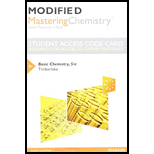
Concept explainers
Indicate the major type of intermolecular forces—(1) ionic bonds. (2) dipole-dipole attractions. (3) hydrogen bonds. (4) dispersion forces—that occurs between particles of the following: (10.6)
a.
d.
Want to see the full answer?
Check out a sample textbook solution
Chapter 10 Solutions
Modified Masteringchemistry With Pearson Etext -- Standalone Access Card -- For Basic Chemistry Format: Access Card Package
- Calcium citrate; MM=498.46 g/mol, a common preservative, has a Ksp of 1.12 x 10^-15 at 25°C.arrow_forwardA 0.25 g ice cube is put into a thermos with 20.0 g of 10.0 C water. Answer the followingquestions:a) Will the ice cube increase or decrease in temperature?b) Will the water increase or decrease in temperature?c) Will the two changes be equal? Why?arrow_forwardNitrogen oxide (NO) has been found to be a key component in many biological processes. It also can react with oxygen to give the brown gas NO2. When one mole of NO reacts with oxygen, 57.0 kJ of heat is evolved.A. Write the thermochemical equation for the reaction between one mole of nitrogen oxide and oxygen.B. Is the reaction exothermic or endothermic?C. What is H when 5.00 grams of nitrogen oxide reacts?D. How many grams of nitrogen oxide must react with an excess of oxygen to liberate ten kilojoules of heat?arrow_forward
- an important flavor component of vanilla extract is vanillin C8H8O3 molar mass = 152.15 g/mol when vanillin burns in a bomb calorimeter with a heat capacity of 12.16 kJ/ celsius the temp increases from 24.56 celsius to 30.60 celsius. if the heat of combustion of vanillin is -3760 kJ/mol what mass of vanillin (in g) was combusted? answer to two decimal placesarrow_forwardGiven the following information: 2 NH3(g) + 3 N2O(g) → 4 N2(g) + 3 H2O(l) ΔHºrxn = -1010 kJ 4 NH3(g) + 3 O2(g) → 2 N2(g) + 6 H2O(l) ΔHºrxn = +1531 kJ Calculate the value of ΔHºrxn for: N2(g) + ½ O2(g) → 2 N2O(g)arrow_forwardCalculate delta H for the following Thanksarrow_forward
- Mercury was once used in thermometers and barometers. What amount of heat (in Joules) is absorbed by 95.7 g of mercury at 25.0oC, if the temperature increases to 27.89oC? The specific heat of mercury is 0.140 J/goC? (Final answer: with ONE decimal place)arrow_forwardUsing the information in the table below, calculate the heat of released from the following reaction in kJ per g of NO. ( Mw. Of NO = 30.01 g/mol). 4NH3(g) + 5O2 (g) 6H2O(g) + 4 NO(g) NH3 H2O NO Hfº (kJ/mol) - 46.1 -241.8 + 90.3arrow_forwardWhat is the specific heat if 1,445.3 J of heat are needed to raise 10 of a substance at 33.1 °C to 89.6 °Carrow_forward
- The heat of neutralization, Hneut, can be defined as the amount of heat released (or absorbed), q, per mole of acid (or base) neutralized. Hneut for nitric acid is -52 kJ/mol HNO3. At 27.3C, 50.00 mL of 0.743M HNO3 is neutralized by 1.00 M Sr(OH)2 in a coffee-cup calorimeter. (a) How many mL of Sr(OH)2 were used in the neutralization? (b) What is the final temperature of the resulting solution? (Use the assumptions in Question 11.)arrow_forwardLiquid menthonal (CH4O) which is used as a cooking fuel, burns with oxygen gas to produce the gases carbon dioxide and water. The reaction produces 363 kJ of heat per mole of methonol. a) write a balanced equation for the reaction includig the heat of the reaction b) is the reaction endothermic or exothermic? c) How many moles of O2 must react with 0.450 mole of CH4O? d) How many grams of CO2 are produced when 78.0 g of Ch4O reacts?arrow_forwardAmmonia will react with fluorine in the gaseous state to produce dinitrogen tetrafluoride and hydrogen fluoride according to the equation: α NH3(g) + β F2(g) → γ N2F4(g) + δ HF(g) The best values for α, β, γ and δ are: A. 2, 1, 1, 6 B. 2, 3, 1, 6 C. 2, 5, 1, 6 D. 2, 10, 1, 6 E. 2, 6, 1, 6arrow_forward
 Introduction to General, Organic and BiochemistryChemistryISBN:9781285869759Author:Frederick A. Bettelheim, William H. Brown, Mary K. Campbell, Shawn O. Farrell, Omar TorresPublisher:Cengage Learning
Introduction to General, Organic and BiochemistryChemistryISBN:9781285869759Author:Frederick A. Bettelheim, William H. Brown, Mary K. Campbell, Shawn O. Farrell, Omar TorresPublisher:Cengage Learning Principles of Modern ChemistryChemistryISBN:9781305079113Author:David W. Oxtoby, H. Pat Gillis, Laurie J. ButlerPublisher:Cengage Learning
Principles of Modern ChemistryChemistryISBN:9781305079113Author:David W. Oxtoby, H. Pat Gillis, Laurie J. ButlerPublisher:Cengage Learning Chemistry: Principles and PracticeChemistryISBN:9780534420123Author:Daniel L. Reger, Scott R. Goode, David W. Ball, Edward MercerPublisher:Cengage Learning
Chemistry: Principles and PracticeChemistryISBN:9780534420123Author:Daniel L. Reger, Scott R. Goode, David W. Ball, Edward MercerPublisher:Cengage Learning Chemistry: Principles and ReactionsChemistryISBN:9781305079373Author:William L. Masterton, Cecile N. HurleyPublisher:Cengage Learning
Chemistry: Principles and ReactionsChemistryISBN:9781305079373Author:William L. Masterton, Cecile N. HurleyPublisher:Cengage Learning



